|
I was quite surprised to read in the February
1962 edition of American Modeler an article titled, "How Erie's 'Morning News' Promoted Flying
Sites for Keystone Klippers" (in 2012, neither the newspaper nor the flying field are still in existence).
Why the surprise, you might ask? Well, Melanie and I moved to Erie in 2008. An Internet search for control
line flying clubs in the area turned up nothing. I finally found a mention of the
Bean Hill Flyers,
a fairly active club for Erie, in a Cleveland club's newsletter, but that was it. Trying to find the
local hobby shops in Erie was a challenge
as well even through there were three at the time (one is gone now). One of the charms of Erie that
attracted us to the area is its old world feel with a strong sense of community and ties to its European
ethnic heritage, but the step back in time seems to have left a few modern aspects for a future date.
That's OK, I've got it now.
How Erie's "Morning News" Promoted Flying Sites for Keystone Klippers
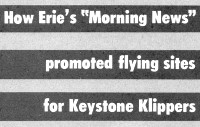 "Land, land everywhere and nary a spot to fly," is the lament
these days of many a modeler from Maine to California. With flying sites scarce you just don't go out
some weekend and run down a spot to plant your wind sock.
Chances are you've heard of clubs which were helped by recreation and park departments, city councils,
county aviation committees, men's service clubs, boards of education. Have you asked all these groups
in your city?
"Oh, yes," you say, "We've asked 'em all right, and know what we got, yards and yards of red tape
and not a square yard of ground."
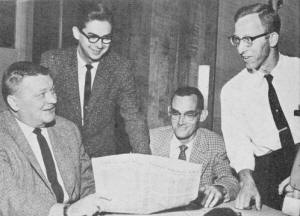 Hugh Barr, city editor of the "Erie Morning News" (left)
discusses article which produced model flying site with (l. to r.) reporter Bob Protzman; Klippers Wayne
Brown, Keith Ostrum (Morning News pix).
So, half a dozen groups turned you down. Don't give up yet! In Erie, Pa., a city of 130,000, the
Keystone Klippers, an A.M.A. chartered club, had appealed to all of these groups, plus a few more, before
they finally got a field of their own.
And, how did they finally get those planes buzzin', cousin? They went to their local newspaper, The
Erie Morning News, and found, at last, a champion in its city editor, Hugh Barr.
Mr. Barr listened as Wayne Brown, then president of the Klippers, and Keith Ostrum, secretary, explained
the Klipper's flying site problem. He felt that they deserved some help and assigned reporter Bob Protzman
to work on an article describing the club and its need.
Bob, not a modeler, took some notes on the organization of the club, its affiliation with the A.M.A.
and a short summary of the types of flying (combat, rat racing and stunt) favored by this all control-line
club. Then he had a photographer at one of the regular club meetings shooting pictures to accompany
the story.
Bob's paper headlined his article, "Model Plane Club 'Airport' Needed." The lead paragraph: "There
is an organization in Erie that is asking for very little. They would like to have a field not smaller
than 500 by 200 feet. They don't care about the condition, they seek only open space. The Keystone Klippers
is a model airplane club."
Bob followed this with detailed info on the club; then concluded, "The Klippers are not asking for
a ready-made plot of land. They are willing to clean up any land they can get, and are interested in
a five-year lease, preferably with option to buy."
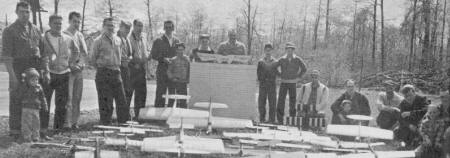 Erie's Keystone Klippers
Group Photo
This newspaper article, run in the "Morning News" on Jan. 11, 1960, within two weeks brought six
offers of flying sites to the Keystone Klippers.
The club members inspected the sites and chose the one which seemed most suitable. Far enough from
any heavily populated area to avoid "noise" complaints, yet not an excessive distance for the modelers
to travel in reaching it, it was only four miles from the center of Erie and one-half mile from the
city limits.
The owner of the field, Clarence Daley of Elgin, Pa., works for the Pennsylvania Railroad and owns
another farm on which he lives. He agreed to a five-year lease arrangement whereby the Klippers acquired
use of the land in exchange for paying the property taxes of about $90 annually for the 12 acres.
The only request by Daley was that the club not bother the tenant of a house located on the property.
This is easy, since the house is surrounded by two acres. Another five acres of the plot are in woodland,
so this left about five acres for the Klippers to use as they saw fit. Members immediately launched
an improvement campaign. They got off to a "red-hot" start by burning a large pile of scrap lumber on
the field.
p
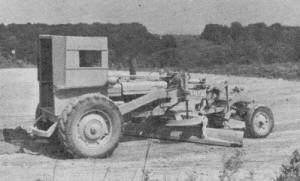 KK's CD, Paul Thomas, runs dozer.
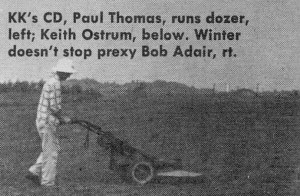
Keith Ostrum mows grass.
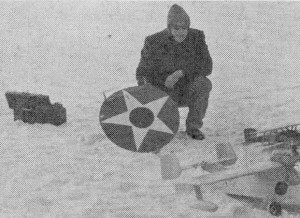
Winter doesn't stop prexy Bob Adair.
As the flames from the lumber pile roared high, the sound of sirens screamed through the air. Nobody
had notified the area hose company of their intentions! The firemen had seen the blaze and thought that
the house was burning.
Next move by the Erie U-controllers toward improvement was less spectacular. They drew up a field
plan and decided what earth had to be moved. They were fortunate in having a member, Paul Thomas, who
drives heavy equipment for a living.
Thus, they were able to rent a bulldozer, which Paul Thomas operated for them one weekend. With the
heavy blade work done, the members temporarily forsook their E-Z handles for rake handles and soon had
one section of the field in good enough shape for temporary flying.
Rental fee on the bulldozer was paid for by a special ticket sale ... this was in the spring of 1960.
Four flying circles of 140-foot diameter were laid out. Grass was grown on three of the circles and
the fourth was kept skinned for rat racing.
That summer, while recouping their finances, the Klippers managed to get by without any further work
except regular maintenance. This was done by the club members whenever necessary.
It was sheer luxury to have a spot to unroll their lines without worrying if the flying session would
be terminated by someone's irate request that they gather up their planes and get lost.
Naturally, all this time, they were making plans to have an even better field in 1961, when more
funds and time were available.
Their first big obligation, of course, was the payment of the taxes, which they had agreed to in
lieu of field rent. Part of the money for this purpose came from dues - 25 cents per month for the seven
members under 16, 50 cents monthly for the 18 open class members.
Their annual A.M.A. sanctioned summer meet also added to the treasury, since most of the prizes were
donated by manufacturers across the country.
By the spring of 1961, the Klippers felt that they were again in a position to make some field improvements,
For one thing, the area needed some more grading work after the winter weather.
The year before the club had been charged $250 for the use of a bulldozer, so they decided to ask
around to see if anyone had any equipment they would loan to the club.
Their persistence paid off when the Eriez Raceway agreed to donate the use of a grader, which was
driven again by Mr. Thomas, who is now the club's contest director.
After the grading was completed they laid out parking areas for members, contestants and the public.
Also, they constructed rest room facilities. This improvement work put them in business for the 1961
flying season.
Because they wanted to share their good fortune with other modelers, the Klippers opened their field
to anyone holding a valid A.M.A. license. An unexpected result of this policy has been the addition
of several former "loners" to the club membership.
Also, last summer, when another predominately control-line group, the Model Airplane Club of Erie,
lost its flying site, the Klippers generously invited them to use their field.
The only other organized modeling group in Erie is the Radio Control Club of Erie. These flyers also
have had their share of site troubles, and have been forced to change locations two or three times in
the last few years.
This past summer they were given permission to fly at Fairway Airport, not far from Erie. This field
is now inoperative and the R/C club has agreed to pay the property taxes there in exchange for flying
rights. They were also required to show proof of liability insurance.
With the acquisition of good flying sites, modeling interests in Erie seem to be on the upswing.
"In fact," say Robert Adair, present Klipper president, and Keith Ostrum, secretary, "Plans for further
flying site improvements next year are already on the drafting board."
The Keystone Klippers hope, in time, to have a control tower with wind sock, permanent concession
stand, oiled rat-race circle, picnic grove, better grass, but time and funds are, as always, a problem.
In the meantime, the Klippers are concentrating on an expanded modeling program. One of the larger
projects which they have undertaken, in cooperation with the Model Airplane Club of Erie and the Radio
Control Club of Erie, is the formation of the Greater Erie Modeling Society, generally referred to as
the GEMS.
The GEMS came into being last April when the officers of the clubs involved met and elected association
officers. Robert Adair, president of the Klippers, was chosen to head the group.
The clubs reasoned that one coordinated group would make it possible to advance model activities
in Erie even faster.
First, as soon as their papers of incorporation are completed, they intend to secure added insurance
coverage of a type available to an incorporated group. This insurance will cover activities other than
A.M.A. sanctioned events.
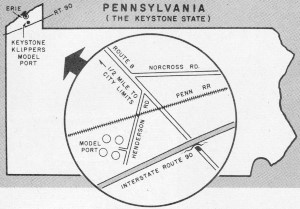
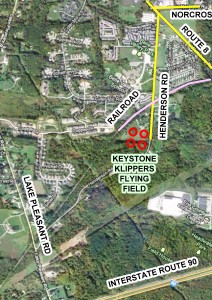
Erie's Keystone Klippers Flying Field Map - Image
on right is 2012 screen shot from
Google MapsSecondly, they hope to promote better representation of the Erie clubs at out-of-town meets. Also,
they plan to hold social affairs and regular annual meetings, which will help all the modelers get to
know each other better, regardless of their flying specialty interests.
The GEMS has a governing board of nine directors, three chosen by each member club. The fees for
the individual clubs are set at 50 cents annually for each member of their club.
Another big project of the Klippers in 1961 was their second annual summer contest, which was a class
AA sanctioned A.M.A. meet. No members competed, electing instead to devote all their energies to making
their visitors welcome, keeping the processing and flying moving smoothly, working in the concession
stand.
Their rewards for this policy were the congratulations of the 30 contestants for a well-run, enjoyable
meet. Also, although money was not their main purpose, the Klippers fattened their "kitty" with an $80
profit from the meet.
Part of these funds came from entrance fees, $1 for first event and 50 cents for each additional.
The charge for the balloon bursting event was 25 cents per try.
The food concession stand was operated by Paul Tirak, the Klipper's vice-president and Mrs, Tirak
and Joe Mientkiewicz, another member. It was possible to keep the prices of the hot dogs, hamburgers,
salads, coffee and soft drinks to a minimum and still show a profit because most of the edible items
were contributed by various food distributors in the area,
Following the match, the club wrote letters of thanks to each of these donors, They also thanked
the local volunteer fire department, which furnished a manned rescue wagon for the day and took care
of first aid.
In addition to contest and sport flying last summer, the Klippers found time to participate in several
community functions where they were given the opportunity to demonstrate or display models and modeling
to the public, On July 2 and 3, they flew at the Air Force Association air show at the municipal airport.
On another occasion, they gave a flying demonstration at intermission time in the stock car races at
Erie Academy Stadium, And, in September, they flew for patients at the local VA hospital
One display wall at the Erie Public Museum. About 30 planes of all types were shown, with descriptive
name cards. The public evidenced considerable interest in the affair and asked many questions.
The Keystone Klippers, who derive their name from Pennsylvania, the "Keystone" state, feel that the
keystone to their many successful activities the past two years has been their acquisition of a good
flying site.
With the security of having their own field, they have been able to turn their time and energies
to more and better modeling.
Posted November 4, 2012
|